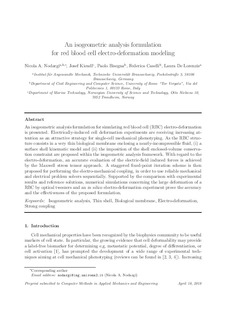| dc.contributor.author | Nodargi, Nicola | |
| dc.contributor.author | Kiendl, Josef | |
| dc.contributor.author | Bisegna, Paolo | |
| dc.contributor.author | Caselli, Federica | |
| dc.contributor.author | De Lorenzis, Laura | |
| dc.date.accessioned | 2019-02-25T11:41:32Z | |
| dc.date.available | 2019-02-25T11:41:32Z | |
| dc.date.created | 2018-04-24T17:47:33Z | |
| dc.date.issued | 2018 | |
| dc.identifier.citation | Computer Methods in Applied Mechanics and Engineering. 2018, 338 392-411. | nb_NO |
| dc.identifier.issn | 0045-7825 | |
| dc.identifier.uri | http://hdl.handle.net/11250/2587222 | |
| dc.description.abstract | An isogeometric analysis formulation for simulating red blood cell (RBC) electro-deformationis presented. Electrically-induced cell deformation experiments are receiving increasing attention as an attractive strategy for single-cell mechanical phenotyping. As the RBC structure consists in a very thin biological membrane enclosing a nearly-incompressible fluid, (i) a surface shell kinematic model and (ii) the imposition of the shell enclosed-volume conservation constraint are proposed within the isogeometric analysis framework. With regard to the electro-deformation, an accurate evaluation of the electric-field induced forces is achieved by the Maxwell stress tensor approach. A staggered fixed-point iteration scheme is then proposed for performing the electro-mechanical coupling, in order to use reliable mechanical and electrical problem solvers sequentially. Supported by the comparison with experimental results and reference solutions, numerical simulations concerning the large deformation of a RBC by optical tweezers and an in silico electro-deformation experiment prove the accuracy and the effectiveness of the proposed formulation. | nb_NO |
| dc.language.iso | eng | nb_NO |
| dc.publisher | Elsevier | nb_NO |
| dc.rights | Attribution-NonCommercial-NoDerivatives 4.0 Internasjonal | * |
| dc.rights.uri | http://creativecommons.org/licenses/by-nc-nd/4.0/deed.no | * |
| dc.title | An isogeometric analysis formulation for red blood cell electro-deformation modeling | nb_NO |
| dc.type | Journal article | nb_NO |
| dc.type | Peer reviewed | nb_NO |
| dc.description.version | acceptedVersion | nb_NO |
| dc.source.pagenumber | 392-411 | nb_NO |
| dc.source.volume | 338 | nb_NO |
| dc.source.journal | Computer Methods in Applied Mechanics and Engineering | nb_NO |
| dc.identifier.doi | 10.1016/j.cma.2018.04.038 | |
| dc.identifier.cristin | 1581372 | |
| dc.description.localcode | © 2018. This is the authors’ accepted and refereed manuscript to the article. Locked until 2.5.2020 due to copyright restrictions. This manuscript version is made available under the CC-BY-NC-ND 4.0 license http://creativecommons.org/licenses/by-nc-nd/4.0/ | nb_NO |
| cristin.unitcode | 194,64,20,0 | |
| cristin.unitname | Institutt for marin teknikk | |
| cristin.ispublished | true | |
| cristin.fulltext | postprint | |
| cristin.qualitycode | 2 | |

